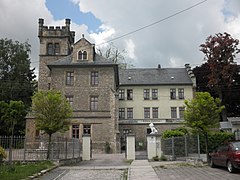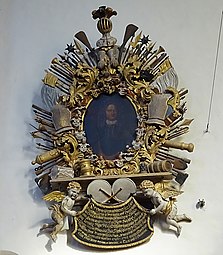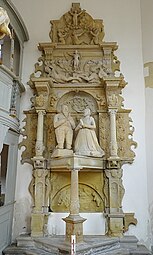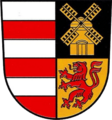Werthern (noble family)
The von Werthern are a noble family from Werther in Thuringia who were raised to the status of barons and counts. It first appeared in a document in 1209 with Heroldus de Wirthere and the family line began with Friedrich von Werthern, who died in 1396 .
history
According to legend, a family of Werther (n) appeared for the first time in 773, when Illibrandus, a distinguished Lombard duke, “in the bloody battle in which the Francken, led by their King Caroli, were victorious over the Longobards , by the said Francken, who also followed the Longobard Empire completely destroyed, slain like many others. "
According to Paulus Götz , the original line of the Lords von Werther (n) should descend from the early medieval Thuringian King Berthachar (Bertharii) in straight male line. The first lord of Werthern was Odobaldus (Adobald), who in 801 or 802 was given a lordship called Werther not far from the Harz and the city of Nordhausen in Thuringia from Charlemagne because of many years of heroic, clever and loyal military service . 1086 Hermann was of Werther, a born Count of Orlien , son of a Countess of Alsace, of which married the only heir of Werther and took thus their possessions and the name of Emperor Henry IV. To imperial Erbkammertürhüter appointed. On this occasion, his coat of arms was extended. In this hereditary function (to be confirmed by the emperors), the Counts von Werthern had to ensure that the secret imperial elections in Frankfurt am Main ran properly until the end of the Holy Roman Empire of the German Nation in 1806.
In the next few centuries "without exception all Wertherns" are said to have moved to the promised land during the crusades (and mostly fell there), they provided a templar lord and later a knight of the Teutonic Order . The Werthern were lords of the later city of Kölleda , which took over the family coat of arms as the city coat of arms. Members of the family also became patricians in the town of Nordhausen , near their ancestral home, where they provided several mayors and councilors. Medieval graves of the Wertherns are located in the Walkenried monastery , where a family grave chapel was set up in the 15th century in the eastern part of the choir of the monastery church.

In 1452 Dietrich von Werthern bought the rule Wiehe with Castle Wiehe and Gut Lossa from Count Heinrich von Schwarzburg as well as the associated patronage over the Donndorf monastery . From 1452 they were bailiffs and from 1540 administrators of the Donndorf monastery. Dietrich's son Hans von Werthern (1443–1533), Privy Councilor of the Dukes of Saxony and the Count of Stolberg and “Governor of Thuringia”, acquired the rule of Brücken (Helme) in 1498 , and in 1505 the Frohndorf estate with Großneuhausen and Bachra . In 1519, he bought by Count Adam von Beichlingen the castle Beichlingen and most of the county Beichlingen with extensive forest holdings on the High-cricket , and in 1528 the village Leubingen . He thereby expanded the property of his family considerably and became the progenitor of the main lines Beichlingen, Brücken and Wiehe. The older Beichlingen line later split up into the Beichlingen-Großneuhausen-Eythra and Frohndorf-Kölleda houses.
Several members of the family refused their proposed imperial count, so u. a. 1509 Baron Johann von Werthern. The Electoral Saxon envoy and Chancellor Georg von Werthern-Beichlingen (1663–1721) was finally raised to the rank of imperial count in 1702 . He had the baroque palace built in Großneuhausen from 1708–11 , which remained his main residence until the family returned to Beichlingen Castle in the 19th century. It was also expropriated in 1945 and demolished in 1948.
After the imperial line with Jacob Friedemann von Werthern (1739–1806) expired in 1806, the former county fell to Baron Ottobald von Werthern on Frohndorf and Kölleda (1794–1878), who in 1840 became the Prussian Count and Lord von Werthern-Beichlingen ( in Primogenitur , with the title Freiherr for the younger sons) was raised.
The family had until the expropriations without compensation in the Soviet occupation zone 1945–1949 a. a. the castles and estates in Beichlingen with Großneuhausen and Kölleda, Leubingen , Stödten , Schönstedt and Frohndorf , in Wiehe , Bachra with Donndorf monastery and bridges (helmets) in their possession, furthermore Hoppenrade in the province of Brandenburg. From 1649 to 1806 she owned the Eythra estate , from 1638 to 1819 the Neunheilingen estate , and also Kroppen in Upper Lusatia. The once magnificent "Palais Werthern" in Dresden fell victim to the destruction of the Seven Years' War (1756–1763). In 1886, Wolff Freiherr von Werthern acquired the Esbach castle and estate from the Bachra line , which remained in family ownership until the middle of the 20th century.
The Werthern produced a large number of important personalities in the civil service and high officers, some became ministers in the Saxon and Prussian services. In 1781 Goethe visited Neunheilingen with Duke Carl August , where he adored the local Countess Johanna ("Jeannette") von Werthern , a highly educated lady; he immortalized his visit in “ Wilhelm Meister's apprenticeship years ”. He also visited the Werthern family in Eythra, Großneuhausen and Frohndorf. A street in Dörfles-Esbach in Franconia and, in 2006, a square in Bachra in northern Thuringia were named after the von Werthern family.
The Hue de Grais Castle in Wolkramshausen was returned to the community of heirs of Count Hue de Grais in 1997, whose member Manfred von Werthern took it over and has it restored.
photos
Kleinwerther Castle
Castle bridges (helmets)
Großneuhausen Castle
Bachra Castle
Eythra Castle (before 1840)
Manor house Frohndorf
Hoppenrade Castle (owned 1872–1945)
Esbach manor
In the St. Wigbert Church in Kölleda there are epitaphs of the family from the Renaissance and Baroque periods. An art-historically valuable Renaissance epitaph from the Friedemann workshop exists in the Church of St. Philippus in Kleinwerther . Other graves are also in the crypt of the Donndorf monastery and with the hereditary burial place in the churchyard in Beichlingen.
coat of arms
Family coat of arms
- The family coat of arms shows a slanted golden tree branch with three (mostly 2: 1) golden leaves on black . On the helmet with black and gold covers a growing gold-crowned black bear (or natural-colored wolf ) (with a gold collar), the crown equipped with three (black-gold-black) ostrich feathers.
- The coat of arms seal of Anthonius von Werthern still shows a three-leaved oak branch and a striding bear on the helmet (or wolf; however, the wolf's characteristic tail, which would indicate this, is missing in the seal imprint ).
- In 1420 the family received an increased coat of arms , in which the coat of arms of the Werthern rule is included. The extended coat of arms is quartered, 1 and 4 show in gold a right-facing gold crowned red lion , in 2 and 3 the main coat of arms. The helmet, which is covered with red and gold blankets on the right and black and gold on the left, remains adorned like the family coat of arms, the three ostrich feathers are colored red, gold and black.
- The count's coat of arms is split three times and split once, with a red field of regalia below . A heart shield , like 1420.
Coat of arms of the von Werthern family in Siebmacher's book of arms (1605)
Coat of arms over the Werthern crypt of the St. Laurentius monastery church (Donndorf)
Heraldic shield on the Dompropstei (Domplatz 3) in Naumburg
Alliance coat of arms of Hoym / von Werthern at the Palais Beichlingen in Dresden
Local coat of arms in connection with the von Werthern family
Some regional local and community coats of arms in the former ancestral lands around the Hohe Schrecke in north-east Thuringia still show, through their composition, the former possession or influence of von Werthern.
Coat of arms of the city of Kölleda
Coat of arms of the former city of Wiehe
Great Monra coat of arms
Bachra coat of arms
Kleinwerther coat of arms
Beichlingen coat of arms
Personalities
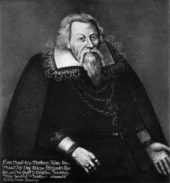

- Alfred von Werthern (1842–1908), Prussian major general
- Anthonius von Werthern († 1513), Council of the Counts of Stolberg, Court Marshal and Council of the Elector of Brandenburg and the Archbishop of Magdeburg
- Dietrich von Werthern , also von Wert (h) erde; (* around 1400; † 1470), Herr auf Wiehe, ancestor of all today's von Werthern
- Dietrich von Werthern , also Dietrich Werther or Dietrich von Wert (h) erde; (* around 1410; † 1482), since 1462 Chancellor of the ruling Count of Stolberg
- Dietrich von Werthern (1468–1536), Chancellor of the Teutonic Order with the Grand Master in East Prussia, Councilor of Duke Georg of Saxony
- Elisabeth Countess von Werthern , b. Countess von Wedel (1916–2009), from 1951 to 1984 managing director of the German Parliamentary Society
- Ernst von Werthern (1841–1916), district administrator and manor owner
- Friedrich von Werthern (1630–1686), privy councilor, court judge
- Friedrich von Werthern (1804–1864), Prussian administrative officer and Sachsen-Meiningen politician
- Georg Graf von Werthern (1663–1721), envoy and chancellor of the Electoral Saxony
- George d. J. Graf von Werthern (1700–1768), chamberlain from the Electorate of Saxony, privy councilor from Weimar
- Georg Graf von Werthern-Beichlingen (1816–1895), diplomat, Prussian envoy to Bavaria 1867–1888, “Bismarck's right hand” in bringing Bavaria closer to the new German Empire
- Gertrud Freiin von Werthern-Beichlingen (1913–1987), ∞I. Hereditary Prince Hermann Otto Wilhelm Ludwig zu Solms-Hohensolms-Lich (1902–1940), ∞II. Writer Hans Joachim Sell ; u. a. Mother of Hermann Otto Solms
- Hans von Werthern (1443–1533), knight and keeper of the Reichserbkammert, Privy Council of the ruling Dukes of Saxony and Count zu Stolberg, bailiff of Gebesee, Weißenfels and Freyburg (Unstrut), inherited Wiehe Castle , acquired the rule of Brücken (Helme) in 1498 , In 1505 the Frohndorf estate with Großneuhausen and Bachra and in 1519 the county and castle of Beichlingen . He is the progenitor of all the still blooming lines of the sex.
- Hans Carl von Werthern (* 1953), diplomat and ambassador to Japan from 2014 to 2019
- Heinrich von Werthern (1838–1879), Prussian administrative officer
- Ingeborg-Maria von Werthern (1913–1996), abbess of the Protestant women's monastery, Stift zum Heiligengrabe (1952–1995)
- Jacob Friedemann Graf von Werthern (1739–1806) Electoral Saxon diplomat
- Johann Georg Heinrich Graf von Werthern (1735–1790), Prussian secret minister of state and Grand Maitre de la Garderobe
- Johanna Luise von Werthern (1752–1811; born Freiin vom und zum Stein ), wife of Jacob Friedemann von Werthern
- Ottobald von Werthern (1794–1878), Prussian landowner and politician, since 1840 Count and Lord von Werthern-Beichlingen
- Thilo von Werthern (1818–1888), landowner, member of the Prussian manor house
literature

- Petrus Albinus : Historia of the ancient lineage of those high and well-bored of the Holy Roman Empire Counts and Lords of Werthern, Roman Imperial Majesty and the Holy Roman Empire Erb-Cammer-Thürhüter, gentlemen on whom Graff and rulers Beichlingen, Werthern, Frohndorff, Wiehe, Brücken, Neuenheilingen, Kroppen and Kleinbalnhausen, As a manuscript by the famous Saxon historico M. Petro Albino Nivemontio, produced more than a hundred years ago, Anietzo overlooked anew and dealt with most of them in such historia, together with the reported author Wapen - and given sexes together in print, also continued by short genealogical tables bit on our times. Published by Jacob Fritsche, Leipzig 1705. Digitized 1705 , digitized 1716
- The von Werther (n) family , in: "Ziering-Moritz-Alemann family association", No. 4, Berlin May 1940
- Genealogical manual of the nobility , Volume 27, 1962, page 496 ff.
- Genealogical manual of the nobility , Volume 137, 2005, Adelslexikon
- Karl Hopf: Historisch-genealogischer Atlas , S. 146f, digitized family tree
- New Prussian Adels Lexicon , p. 477f, digitized version, supplementaryvolume
- New general German Adels Lexicon , Volume 9, p. 539, digitized
- History of the family of the Counts and Barons von Werthern, Naumburg 1907.
- Gothaisches genealogical pocket book of baronial houses, 1857 p.841ff (historical overview) , 1874 p.812ff
Individual evidence
- ↑ grossneuhausen.de website of the municipality Großneuhausen
Web links
- The von Werthern family in the Wildenfels Castle Archives
- Werthern. In: Johann Heinrich Zedler : Large complete universal lexicon of all sciences and arts . Volume 55, Leipzig 1748, column 679 ff.







